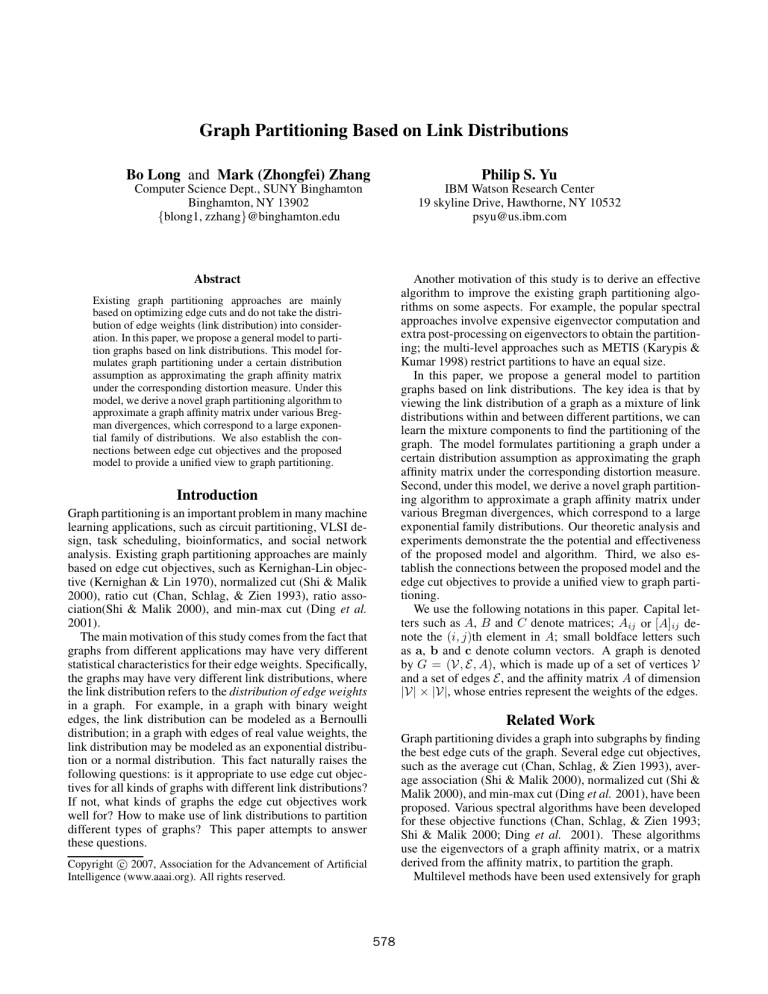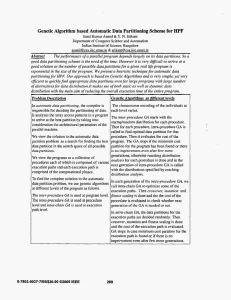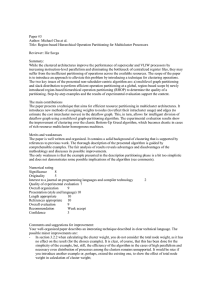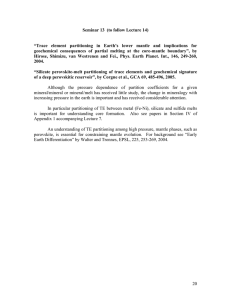Graph Partitioning Based on Link Distributions Philip S. Yu
advertisement

Graph Partitioning Based on Link Distributions
Bo Long and Mark (Zhongfei) Zhang
Philip S. Yu
Computer Science Dept., SUNY Binghamton
Binghamton, NY 13902
{blong1, zzhang}@binghamton.edu
IBM Watson Research Center
19 skyline Drive, Hawthorne, NY 10532
psyu@us.ibm.com
Another motivation of this study is to derive an effective
algorithm to improve the existing graph partitioning algorithms on some aspects. For example, the popular spectral
approaches involve expensive eigenvector computation and
extra post-processing on eigenvectors to obtain the partitioning; the multi-level approaches such as METIS (Karypis &
Kumar 1998) restrict partitions to have an equal size.
In this paper, we propose a general model to partition
graphs based on link distributions. The key idea is that by
viewing the link distribution of a graph as a mixture of link
distributions within and between different partitions, we can
learn the mixture components to find the partitioning of the
graph. The model formulates partitioning a graph under a
certain distribution assumption as approximating the graph
affinity matrix under the corresponding distortion measure.
Second, under this model, we derive a novel graph partitioning algorithm to approximate a graph affinity matrix under
various Bregman divergences, which correspond to a large
exponential family distributions. Our theoretic analysis and
experiments demonstrate the the potential and effectiveness
of the proposed model and algorithm. Third, we also establish the connections between the proposed model and the
edge cut objectives to provide a unified view to graph partitioning.
We use the following notations in this paper. Capital letters such as A, B and C denote matrices; Aij or [A]ij denote the (i, j)th element in A; small boldface letters such
as a, b and c denote column vectors. A graph is denoted
by G = (V, E, A), which is made up of a set of vertices V
and a set of edges E, and the affinity matrix A of dimension
|V| × |V|, whose entries represent the weights of the edges.
Abstract
Existing graph partitioning approaches are mainly
based on optimizing edge cuts and do not take the distribution of edge weights (link distribution) into consideration. In this paper, we propose a general model to partition graphs based on link distributions. This model formulates graph partitioning under a certain distribution
assumption as approximating the graph affinity matrix
under the corresponding distortion measure. Under this
model, we derive a novel graph partitioning algorithm to
approximate a graph affinity matrix under various Bregman divergences, which correspond to a large exponential family of distributions. We also establish the connections between edge cut objectives and the proposed
model to provide a unified view to graph partitioning.
Introduction
Graph partitioning is an important problem in many machine
learning applications, such as circuit partitioning, VLSI design, task scheduling, bioinformatics, and social network
analysis. Existing graph partitioning approaches are mainly
based on edge cut objectives, such as Kernighan-Lin objective (Kernighan & Lin 1970), normalized cut (Shi & Malik
2000), ratio cut (Chan, Schlag, & Zien 1993), ratio association(Shi & Malik 2000), and min-max cut (Ding et al.
2001).
The main motivation of this study comes from the fact that
graphs from different applications may have very different
statistical characteristics for their edge weights. Specifically,
the graphs may have very different link distributions, where
the link distribution refers to the distribution of edge weights
in a graph. For example, in a graph with binary weight
edges, the link distribution can be modeled as a Bernoulli
distribution; in a graph with edges of real value weights, the
link distribution may be modeled as an exponential distribution or a normal distribution. This fact naturally raises the
following questions: is it appropriate to use edge cut objectives for all kinds of graphs with different link distributions?
If not, what kinds of graphs the edge cut objectives work
well for? How to make use of link distributions to partition
different types of graphs? This paper attempts to answer
these questions.
Related Work
Graph partitioning divides a graph into subgraphs by finding
the best edge cuts of the graph. Several edge cut objectives,
such as the average cut (Chan, Schlag, & Zien 1993), average association (Shi & Malik 2000), normalized cut (Shi &
Malik 2000), and min-max cut (Ding et al. 2001), have been
proposed. Various spectral algorithms have been developed
for these objective functions (Chan, Schlag, & Zien 1993;
Shi & Malik 2000; Ding et al. 2001). These algorithms
use the eigenvectors of a graph affinity matrix, or a matrix
derived from the affinity matrix, to partition the graph.
Multilevel methods have been used extensively for graph
c 2007, Association for the Advancement of Artificial
Copyright Intelligence (www.aaai.org). All rights reserved.
578
partitioning with the Kernighan-Lin objective, which attempts to minimize the cut in the graph while maintaining
equal-sized clusters (Bui & Jones 1993; Hendrickson & Leland ; Karypis & Kumar 1998). In multilevel algorithms,
the graph is repeatedly coarsened level by level until only a
small number of nodes are left. Then, an initial partitioning
on this small graph is performed. Finally, the graph is uncoarsened level by level, and at each level, the partitioning
from the previous level is refined using a refinement algorithm.
Recently, graph partitioning with an edge cut objective has been shown to be mathematically equivalent to an
appropriately weighted kernel k-means objective function
(Dhillon, Guan, & Kulis 2004; 2005). Based on this equivalence, the weighted kernel k-means algorithm has been proposed for graph partitioning (Dhillon, Guan, & Kulis 2004;
2005). Yu, Yu, & Tresp (2005) propose graph-factorization
clustering for the graph partitioning, which seeks to construct a bipartite graph to approximate a given graph. Long
et al. (2006) propose a framework of relation summary network to cluster K-partite graphs.
Another related field is unsupervised learning with Bregman divergences (S.D.Pietra 2001; Wang & Schuurmans
2003). Banerjee et al. (2004b) generalizes the classic kmeans to Bregman divergences. A generalized co-clustering
framework is presented by Banerjee et al. (2004a) wherein
any Bregman divergence can be used in the objective function.
v4
v1
v3
v5
v2
v6
(a)
1
1
1 0
0
0
1
1
1 0
1
0
1
1
1 0
0
0
0
0
0 1
1
1
0
1
0 1
1
1
0
0
0 1
1
1
(b)
Figure 1: A graph with two partitions (a) and its graph affinity matrix (b).
θV2 V2 = 1, and fV1 V2 (x; θV1 V2 ) with θV1 V2 = 19 . Note
that fVV is a mixture of fV1 V1 , fV2 V2 and fV1 V2 , which can
3
9
3
be verified by θVV = 15
θV1 V1 + 15
θV1 V2 + 15
θV2 V2 (the
9
mixing probability for fV1 V2 , 15 , follows the fact that the
number of possible edges between V1 and V2 is 9; similarly
for other proportion probabilities).
Learning mixture components of the link distribution of a
graph is much more difficult than learning a traditional mixture model, since the graph structure needs to be considered,
i.e., our goal is to find the mixture components associated
with subgraphs and not just to simply draw the similar edges
from anywhere in the graph to form a component. For example, in Figure 1(a), without considering the graph structure,
the edge weights from two partitions V1 and V2 cannot be
separated. To tackle this difficulty, we model the problem
based on the graph affinity matrix, which contains all the
information for a graph.
Figure 1(b) shows the graph affinity matrix for the graph
in Figure 1(a). We observe that if the vertices within
the same partition are arranged together, the edge weights
within and between partitions form the diagonal blocks and
off-diagonal blocks, respectively. Hence, learning the link
distribution in a graph is equivalent to learning different distributions for non-overlapping blocks in the graph affinity
matrix. To estimate the sufficient statistic for each block,
we need to solve the problem of likelihood maximization.
It is shown that maximizing likelihood under a certain distribution corresponds to minimizing distance under the corresponding distortion measure (Collins, Dasgupta, & Reina
2001). For example, the normal distribution, Bernoulli distribution, multinomial distribution and exponential distribution correspond to Euclidean distance, logistic loss, KLdivergence and Itakura-Satio distance, respectively. Therefore, learning the distributions of the blocks in a graph affinity matrix can be formulated as approximating the affinity
matrix under a certain distortion measure. Formally, we define graph partitioning as the following optimization problem of matrix approximation.
Definition 2. Given a graph G = (V, E, A) where A ∈
Rn×n , a distance function D, and a positive integer k, the
optimized partitioning is given by the minimization,
Model Formulation
We first define the link distribution as the follows.
Definition 1. Given a graph G = (V, E, A), the link distribution fV1 V2 is the probability density of edge weights between nodes in V1 and V2 , where V1 , V2 ⊆ V.
Based on Definition 1, the link distribution for the
whole graph G is fVV . The model assumption is that
if G has k disjoint partitions V1 , . . . , Vk , then fVV =
πij fVi Vj , where πij is the mixing probability
1≤i≤j≤k
such that 1≤i≤j≤k πij = 1. Basically, the assumption
states that the link distribution of a graph is a mixture of the
link distributions within and between partitions. The intuition behind the assumption is that the vertices within the
same partition are related in a (statistically) similar way to
each other and the vertices from different partitions are related in different ways to each other from those within the
same partition. In Section 5, we show that the traditional
edge cut objectives also implicitly make this assumption under a normal distribution with extra constraints.
Let us have an illustrative example. Figure 1(a) shows
a graph of six vertices and seven unit weight edges. It is
natural to partition the graph into two components, V1 =
{v1 , v2 , v3 } and V2 = {v4 , v5 , v6 }. The link distribution
of the whole graph can be modeled as a Bernoulli distribu7
tion fVV (x; θVV ) with the parameter θVV = 15
(the number of edges in the graph is 7 and the number of possible edges is 15). Similarly, the link distributions for edges
within and between V1 and V2 are Bernoulli distributions,
fV1 V1 (x; θV1 V1 ) with θV1 V1 = 1, fV2 V2 (x; θV2 V2 ) with
min
C∈{0,1}n×k ,B∈Rk×k
D(A, CBC T ),
(1)
where
C ∈ {0, 1}n×k is an indicator matrix such that
C
j ij = 1, i.e., Cij = 1 indicates that the ith vertex belongs to the jth partition, andD is a separable distance
function such that D(X, Y ) = i,j D(Xij , Yij ).
579
without normal matrix multiplication, since C is an indicator matrix.
Then, we fix B and update C. Since each row of C is an
indicator vector with only one element equal to 1, we adopt
the re-assignment procedure to update C row by row. To
determine which element of the hth row of C is equal to 1,
for p = 1, . . . , k, each time we let Chp = 1 and compute the
objective function L = ||A − CBC T ||2 , which is denoted
as Lp , then
We call the model in Definition 2 as the Graph Partitioning with Link Distribution (GPLD). GPLD provides not only
the partitioning of the given graph, which is denoted by the
partition indicator matrix C, but also the partition representative matrix B, which consists of the sufficient statistics
for edge weights
within
and between partitions. For exam1
1/9
ple, B = 1/9 1
for the example in Fig 1(b). B also
provides an intuition about the quality of the partitioning,
since the larger the difference between the diagonal and the
off-diagonal elements, the better the partitions are separated.
Note that GPLD does not restrict A to be symmetric or nonnegative. Hence, it is possible to apply GPLD to directed
graphs or graphs with negative weights, though in this paper our main focus is undirected graphs with non-negative
weights.
Chp∗ = 1 for p∗ = arg min Lp
p
Note that when we update the hth row of C, the necessary
computation involves only the hth row or column of A and
CBC T .
Therefore, updating rules (6) and (7) provide a new graph
partitioning algorithm, GPLD under Euclidean distance.
Presumably for a specific distance function used in Definition 2, we need to derive a specific algorithm. However, a large number of useful distance functions, such as
Euclidean distance, generalized I-divergence, and KL divergence, can be generalized as the Bregman divergences
(S.D.Pietra 2001; Banerjee et al. 2004b), which correspond
to a large number of exponential family distributions. Moreover, the nice properties of Bregman divergences make it
easy to generalize updating rules (6) and (7) to all Bregman divergences. The definition of a Bregman divergence
is given as follows.
Definition 4. Given a strictly convex function, φ : S → R,
defined on a convex set S ⊆ Rd and differentiable on the
interior of S, int(S), the Bregman divergence Dφ : S ×
int(S) → [0, ∞) is defined as
Algorithm Derivation
First we derive an algorithm for GPLD model based on the
most popular distance function, Euclidean distance function.
Under Euclidean distance function, our task is
min
C∈{0,1}n×k ,B∈Rk×k
||A − CBC T ||2 .
(2)
We prove the following theorem which is the basis of our
algorithm.
k×k
Theorem 3. If C ∈ {0, 1}n×k and B ∈ R+
is the optimal
solution to the minimization in (2), then
B = (C T C)−1 C T AC(C T C)−1 .
(3)
Proof. The objective function in Definition 2 can be expanded as follows.
L
Dφ (x, y) = φ(x) − φ(y) − (x − y)T ∇φ(y),
2
=
||A − CBC ||
=
tr((A − CBC T )T (A − CBC T ))
=
tr(AT A) − 2tr(CBC T A) + tr(CBC T CBC T )
T
Solve
∂L
∂B
(4)
= 0 to obtain
B = (C T C)−1 C T AC(C T C)−1 ;
min Ev [Dφ (X, s)]
(9)
s∈S
(5)
has a unique minimizer given by s∗ = Ev [X].
The proof of Theorem 5 is omitted (please refer
(S.D.Pietra 2001; Banerjee et al. 2004b)). Theorem 5 states
that the Bregman representative of a random variable is always the expectation of the variable. Hence, when given a
sample of a random variable, the optimal estimation of the
Bregman representative is always the mean of the sample.
Under the GPLD model, Bpq is the Bregman representative
of each block of an affinity matrix. When C is given, i.e., the
membership of each block is known, according to Theorem
5, Bpq is obtained as the mean of each block,
This completes the proof of the theorem.
Based on Theorem 3, we propose an alternative optimization algorithm, which alternatively updates B and C until
convergence. We first fix C and update B. Eq (3) in Theorem 3 provides an updating rule for B,
B = (C T C)−1 C T AC(C T C)−1 .
(8)
where ∇φ is the gradient of φ.
Table 1 shows a list of popular Bregman divergences and
their corresponding Bregman convex functions. The following Theorem provide an important property of Bregman divergence.
Theorem 5. Let X be a random variable taking values in
X = {xi }ni=1 ⊂ S ⊆ Rd following v. Given a Bregman
divergence Dφ : S × int(S) → [0, ∞), the problem
Take the derivative with respect to B, we obtain
∂L
= −2C T BC + 2C T CBC T C.
∂B
(7)
(6)
This updating rule can be implemented more efficiently
than it appears. First, it does not really involve computing inverse matrices, since C T C is a special diagonal matrix with the size of each cluster on its diagonal such that
[C T C]pp = |πp |, where |πp | denotes the size of the pth partitioning; second, the product of C T AC can be calculated
Bpq =
1
Aij ,
|πp ||πq | i∈π ,j∈π
p
580
q
(10)
Table 1: A list of Bregman divergences and the corresponding convex functions.
Name
Euclidean distance
Generalized I-divergence
Logistic loss
Itakura-Saito distance
Hinge loss
KL-divergence
Mahalanobis distance
Dφ (x, y)
||x − y||2
Pd
Pd
xi
i=1 xi log( yi ) −
i=1 (xi − yi )
x log( xy ) + (1 − x) log( 1−x
)
1−y
x
− log xy − 1
y
max{0, −2sign(−y)x}
Pd
xi
i=1 xi log( yi )
(x − y)T A(x − y)
φ(x)
||x||2
Pd
i=1 xi log(xi )
x log(x) + (1 − x) log(1 − x)
− log x
|x|
Pd
x
i=1 i log(xi )
xT Ax
Domain
Rd
Rd+
{0, 1}
(0, ∞)
R \ {0}
d-Simplex
Rd
A Unified View to Graph Partitioning
Algorithm 1 Graph Partitioning with Bregman Divergences
Input: A graph affinity matrix A, a Bregman divergence
Dφ , and a positive integer k.
Output: A partition indicator matrix C and a partition representative matrix B.
Method:
1: Initialize B.
2: repeat
3:
for h = 1 to n do
4:
Chp∗ = 1 for p∗ = arg minp Lp where Lp denotes
Dφ (A, CBC T ) for Chp = 1.
5:
end for
6:
B = (C T C)−1 C T AC(C T C)−1 .
7: until convergence
In this section, we establish the connections between the
GPLD model and the edge cut objectives to provide a unified
view for graph partitioning.
In general, the edge cut objectives, such as ratio association (Shi & Malik 2000), ratio cut(Chan, Schlag, & Zien
1993), Kernighan-Lin objective (Kernighan & Lin 1970),
and normalized cut (Shi & Malik 2000), can be formulated as the following trace maximization (Zha et al. 2002;
Dhillon, Guan, & Kulis 2004; 2005),
max tr(C̃ T AC̃).
(11)
In (11), typically C̃ is a weighted indicator matrix such that
1
if vi ∈ πj
1
|πj | 2
C̃ij =
0
otherwise
where |πj | denotes the number of nodes in the jth partition.
and
In other words, C̃ satisfies the constraints C̃ ∈ Rn×k
+
C̃ T C̃ = Ik , where Ik is the k × k identity matrix.
We propose the following theorem to show that the various edge cut objectives are mathematically equivalent to
a special case of the GPLD model. To be consistent with
the weighted indicator matrix used in edge cut objects, in
the following theorem we modify the constraints on C as
C ∈ R+ and C T C = Ik to make C to be a weighted indicator matrix.
Theorem 6. The GPLD model under Euclidean distance
function and B = rIk for r > 0, i.e.,
min ||A − C(rIk )C T ||2
(12)
where πp and πq denote the pth and the qth cluster, respectively, and 1 ≤ p ≤ k, 1 ≤ q ≤ k, 1 ≤ i ≤ n and
1 ≤ j ≤ n. If we write Eq (10) in a matrix form, we
obtain Eq. (3), i.e., Theorem 3 is true for all Bregman divergences. Hence, updating rule (6) is applicable to GPLD
with any Bregamen divergneces. For updating rule (7), there
is only a minor change for a given Bregman divergence, i.e.,
we calculate the object function L based on this given bregman divergence.
Therefore, we obtain a general graph partitioning algorithm, Graph Partitioning with Bregman Divergences
(GPBD), which is summarized in Algorithm 1. Unlike the
traditional graph partitioning approaches, this simple algorithm is capable of partitioning graphs under different link
distribution assumptions by adopting different Bregman divergences. The computational complexity of GPBD can be
shown to be O(tn2 k) for t iterations. For a sparse graph, it
is reduced to O(t|E|k). GPBD is faster than the popular
spectral approaches, which involve expensive eigenvector
computation (typically O(n3 )) and extra post-processing on
eigenvectors to obtain the partitioning. Comparing with the
multi-level approaches such as METIS (Karypis & Kumar
1998), GPBD does not restrict partitions to have an equal
size.
The convergence of Algorithm 1 is guaranteed based on
the following facts. First, based on Theorem 3 and Theorem
5, the objective function is non-increasing under updating
rule (6); second, by the criteria for reassignment in updating
rule (7), it is trivial to show that the objective function is
non-increasing under updating rule (7).
C∈Rn×k
,
+
C T C=Ik
is equivalent to the maximization
max tr(C T AC),
where tr denotes the trace of a matrix.
(13)
Proof. Let L denote the objective function in Eq. 12.
L
= ||A − rCC T ||2
= tr((A − rCC T )T (A − rCC T ))
= tr(AT A) − 2rtr(CC T A) + r2 tr(CC T CC T )
= tr(AT A) − 2rtr(C T AC) + r2 k
The above deduction uses the property of trace tr(XY ) =
tr(Y X). Since tr(AT A), r and k are constants, the
minimization of L is equivalent to the maximization of
tr(C T AC). The proof is completed.
581
struct real graphs based on various data sets from the 20newsgroups (Lang 1995) data, which contains about 20, 000
articles from the 20 news groups and can be used to generate
data sets of different sizes, balances and difficulty levels. We
pre-process the data by removing stop words and file headers
and selecting the top 2000 words by the mutual information.
Each document is represented by a term-frequency vector
using TF-IDF weights and the cosine similarity is adopted
for the edge weight. Specific details of data sets are listed
in Table 3. For example, the third row of Table 3 shows
that three data sets NG5-1, NG5-2 and NG5-3 are generated
by sampling from five newsgroups with size 900, 1200 and
1450, respectively, and with balance 1.5, 2.5, and 4, respectively. Here balance denotes the ratio of the largest partition
size to the smallest partition size in a graph. Normalized
Mutual Information (NMI) (Strehl & Ghosh 2002) is used
for performance measure, which is a standard way to measure the cluster quality. The final performance score is the
average of twenty runs.
Table 4 shows the NMI scores of the four algorithms. For
the synthetic data syn1 and syn3 with normal link distribution, the GPBD-ED algorithm, which assumes normal distribution for the links, provides the best NMI score. Similarly,
for data syn2 with poisson link distribution, the GPBD-GI
algorithm, which assumes poisson distribution for the links,
provides the best performance.
For real graphs, we observe that GPBD-GI provides best
NMI scores for all the graphs and preforms significantly better than NC and METIS in most graphs . This implies that
link distributions of the graphs are closer to Poisson distribution than normal distribution. How to determine appropriate
link distribution assumption for a given graph is beyond the
scope of this paper. However, the result shows that the appropriate link distribution assumption (appropriate distance
function for GPBD) leads to a significant improvement on
the partitioning quality. For example, for the graph NG2-3,
even NC totally fails and other algorithms perform poorly,
GPBD-IS still provides satisfactory performance. We observe that all the algorithms perform poorly for NG10. One
possible reason for this is that in NG10 some partitions are
heavily overlapped and very unbalanced. We also observe
that the performance of the GPBD with the appropriate distribution is more robust to unbalanced graphs. For example, from NG2-1 to NG2-3, the performance of GPBD-IS
decreases much less than those of NC and METIS. One possible reason for METIS’s performance deterioration on unbalanced graphs is that it restricts partitions to have equal
size.
Table 2: Summary of the synthetic graphs
Graph
syn1
2
4
2
syn2
syn3
4
Parameter
3
3
2.7
3
2.7
2.7
2.7
2.7
3
6.9
7
6.3
7
6.3
6.3
6.3
6.3
7
R20×20
3
n
k
distribution
5
300
3
Normal
600
3
Poisson
20000
20
Normal
3
5
Theorem 6 states that with the partition representative matrix B restricted to be of the form rIk , the GPLD model under Euclidean distance is reduced to the trace maximization
in (13). Since various edge cut objectives can be formulated
as the trace maximization, Theorem 6 establishes the connection between the GPLD model and the existing edge cut
objective functions.
Based on this connection, edge cut objectives make two
implicit assumptions for a graph’s link distribution. First,
Euclidean distance in Theorem 6 implies normal distribution assumption for the edge weights in a graph. Second,
since the off-diagonal entries in B represent the mean edge
weights between partitions and the diagonal elements of B
represent the the mean edge weights within partitions, restricting B to be of the form rIk for r > 0 implies that the
edges between partitions are very sparse (close to 0) and the
edge weights within partitions have the same positive expectation r. However, these two assumptions are not appropriate for the graphs whose link distributions deviate from
normal distribution or dense graphs. Therefore, compared
with the edge cut based approaches, the GPBD algorithm
is more flexible to deal with graphs with different statistic
characteristics.
Experimental Results
Although GPBD actually provides a family of algorithms
under various Bregman divergences, due to the space limit,
in this paper we present the experimental evaluation of the
effectiveness of the GPBD algorithm under two most popular divergences, GPBD under Euclidean Distance (GPBDED) corresponding to normal distribution, and GPBD under Generalized I-divergence (GPBD-GI) corresponding to
Poisson distribution, in comparison with two representative
graph partitioning algorithms, Normalized Cut (NC) (Shi
& Malik 2000; Ng, Jordan, & Weiss 2001) and METIS
(Karypis & Kumar 1998).
We use synthetic data to simulate graphs whose edge
weights are under normal and poisson distributions. The distribution parameters to generate the graphs are listed in the
second column of Table 2 as matrices. In a parameter matrix
P , Pij denotes the distribution parameter that generates the
edge weights between the nodes in the ith partition and the
nodes in the jth partition. Graph syn3 has twenty partitions
of 20000 nodes and about 10 million edges. Due to the space
limit, its distribution parameters are omitted here.
The graphs based on the text data have been widely used
to test graph partitioning algorithms (Ding et al. 2001;
Dhillon 2001; Zha et al. 2001). In this study, we con-
Conclusion
In this paper, we propose a general model to partition graphs
based on link distribution. This model formulates graph partitioning under a certain distribution assumption as approximating the graph affinity matrix under the corresponding
distortion measure. Under this model, we derive a novel
graph partitioning algorithm to approximate a graph affinity matrix under various Bregman divergences, which correspond to a large exponential family of distributions. Our
theoretic analysis and experiments demonstrate the potential
582
Table 3: Subsets of Newsgroup Data for constructing graphs.
Name
NG2-1/2/3
NG3-1/2/3
NG5-1/2/3
NG10
Newsgroups Included
alt.atheism, comp.graphics
comp.graphics, rec.sport.hockey,talk.religion.misc
comp.os.ms-windows.misc, comp.windows.x,
rec.motorcycles,sci.crypt, sci.space
comp.graphics, comp.sys.ibm.pc.hardware, rec.autos,
rec.sport.baseball,sci.crypt, sci.med,comp.windows.x,
soc.religion.christian, talk.politics.mideast,talk.religion.misc
# Documents
330/525/750
480/675/900
Balance
1.2/2.5/4
1.2/2.5/4
900/1200/1450
1.5/2.5/4
5600
7
Table 4: NMI scores of the five algorithms
Data
syn1
syn2
syn3
NG2-1
NG2-2
NG2-3
NG3-1
NG3-2
NG3-3
NG5-1
NG5-2
NG5-3
NG10
NC
0.673 ± 0.081
0.648 ± 0.052
0.801 ± 0.029
0.482 ± 0.299
0.047 ± 0.041
0.042 ± 0.023
0.806 ± 0.108
0.185 ± 0.116
0.048 ± 0.013
0.598 ± 0.077
0.5612 ± 0.030
0.426 ± 0.060
0.281 ± 0.011
METIS
0.538 ± 0.016
0.533 ± 0.018
0.799 ± 0.010
0.759 ± 0.024
0.400 ± 0.000
0.278 ± 0.000
0.810 ± 0.017
0.501 ± 0.012
0.546 ± 0.016
0.616 ± 0.032
0.570 ± 0.020
0.574 ± 0.018
0.310 ± 0.017
and effectiveness of the proposed model and algorithm. We
also show the connections between the traditional edge cut
objectives and the proposed model to provide a unified view
to graph partitioning.
GPBD-ED
0.915 ± 0.017
0.828 ± 0.139
0.933 ± 0.047
0.678 ± 0.155
0.283 ± 0.029
0.194 ± 0.008
0.718 ± 0.128
0.371 ± 0.131
0.235 ± 0.091
0.550 ± 0.043
0.546 ± 0.032
0.515 ± 0.033
0.308 ± 0.015
GPBD-GI
0.893 ± 0.072
0.863 ± 0.111
0.811 ± 0.055
0.824 ± 0.045
0.579 ± 0.073
0.356 ± 0.027
0.852 ± 0.081
0.727 ± 0.070
0.631 ± 0.179
0.662 ± 0.025
0.670 ± 0.022
0.668 ± 0.035
0.335 ± 0.009
Karypis, G., and Kumar, V. 1998. A fast and high quality multilevel scheme for partitioning irregular graphs. SIAM J. Sci. Comput. 20(1):359–392.
Kernighan, B., and Lin, S. 1970. An efficient heuristic procedure for partitioning graphs. The Bell System Technical Journal
49(2):291–307.
Lang, K. 1995. News weeder: Learning to filter netnews. In
ICML.
Long, B.; Wu, X.; Zhang, Z. M.; and Yu, P. S. 2006. Unsupervised learning on k-partite graphs. In KDD-2006.
Ng, A.; Jordan, M.; and Weiss, Y. 2001. On spectral clustering:
Analysis and an algorithm. In Advances in Neural Information
Processing Systems 14.
S.D.Pietra, V.D.Pietera, J. 2001. Duality and auxiliary functions for bregman distances. Technical Report CMU-CS-01-109,
Carnegie Mellon University.
Shi, J., and Malik, J. 2000. Normalized cuts and image segmentation. IEEE Transactions on Pattern Analysis and Machine
Intelligence 22(8):888–905.
Strehl, A., and Ghosh, J. 2002. Cluster ensembles – a knowledge
reuse framework for combining partitionings. In AAAI 2002, 93–
98.
Wang, S., and Schuurmans, D. 2003. Learning latent variable
models with bregman divergences. In IEEE International Symposium on Information Theory.
Yu, K.; Yu, S.; and Tresp, V. 2005. Soft clustering on graphs. In
NIPS’05.
Zha, H.; Ding, C.; Gu, M.; He, X.; and Simon, H. 2001. Bi-partite
graph partitioning and data clustering. In ACM CIKM’01.
Zha, H.; Ding, C.; Gu, M.; He, X.; and Simon, H. 2002. Spectral
relaxation for k-means clustering. Advances in Neural Information Processing Systems 14.
Acknowledgement
This work is supported in part by NSF (IIS-0535162), AFRL
(FA8750-05-2-0284), and AFOSR (FA9550-06-1-0327).
References
Banerjee, A.; Dhillon, I. S.; Ghosh, J.; Merugu, S.; and Modha,
D. S. 2004a. A generalized maximum entropy approach to bregman co-clustering and matrix approximation. In KDD, 509–514.
Banerjee, A.; Merugu, S.; Dhillon, I. S.; and Ghosh, J. 2004b.
Clustering with bregman divergences. In SDM.
Bui, T. N., and Jones, C. 1993. A heuristic for reducing fill-in in
sparse matrix factorization. In PPSC, 445–452.
Chan, P. K.; Schlag, M. D. F.; and Zien, J. Y. 1993. Spectral kway ratio-cut partitioning and clustering. In DAC ’93, 749–754.
Collins, M.; Dasgupta, S.; and Reina, R. 2001. A generalizaionof principal component analysis to the exponential family.
In NIPS’01.
Dhillon, I.; Guan, Y.; and Kulis, B. 2004. A unified view of kernel
k-means, spectral clustering and graph cuts. Technical Report
TR-04-25, University of Texas at Austin.
Dhillon, I.; Guan, Y.; and Kulis, B. 2005. A fast kernel-based
multilevel algorithm for graph clustering. In KDD ’05.
Dhillon, I. S. 2001. Co-clustering documents and words using
bipartite spectral graph partitioning. In KDD, 269–274.
Ding, C. H. Q.; He, X.; Zha, H.; Gu, M.; and Simon, H. D. 2001.
A min-max cut algorithm for graph partitioning and data clustering. In Proceedings of ICDM 2001, 107–114.
Hendrickson, B., and Leland, R. A multilevel algorithm for partitioning graphs. In Supercomputing ’95.
583






